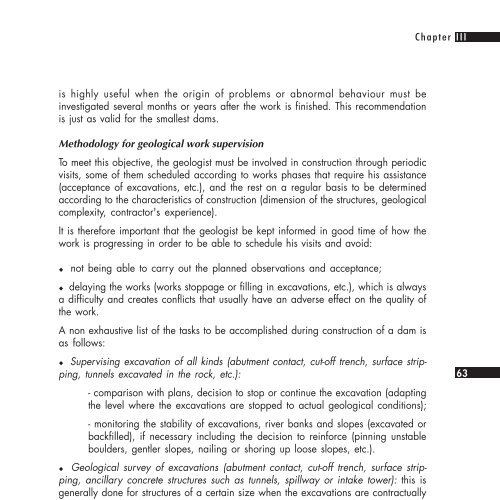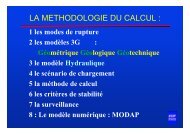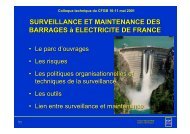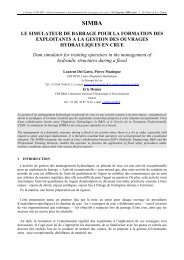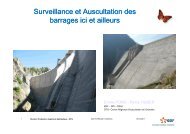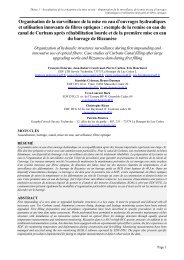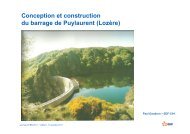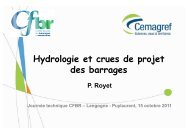SMALL DAMS
SMALL DAMS - Comité Français des Barrages et Réservoirs
SMALL DAMS - Comité Français des Barrages et Réservoirs
- No tags were found...
Create successful ePaper yourself
Turn your PDF publications into a flip-book with our unique Google optimized e-Paper software.
Chapter III<br />
is highly useful when the origin of problems or abnormal behaviour must be<br />
investigated several months or years after the work is finished. This recommendation<br />
is just as valid for the smallest dams.<br />
Methodology for geological work supervision<br />
To meet this objective, the geologist must be involved in construction through periodic<br />
visits, some of them scheduled according to works phases that require his assistance<br />
(acceptance of excavations, etc.), and the rest on a regular basis to be determined<br />
according to the characteristics of construction (dimension of the structures, geological<br />
complexity, contractor's experience).<br />
It is therefore important that the geologist be kept informed in good time of how the<br />
work is progressing in order to be able to schedule his visits and avoid:<br />
!" not being able to carry out the planned observations and acceptance;<br />
!"delaying the works (works stoppage or filling in excavations, etc.), which is always<br />
a difficulty and creates conflicts that usually have an adverse effect on the quality of<br />
the work.<br />
A non exhaustive list of the tasks to be accomplished during construction of a dam is<br />
as follows:<br />
!" Supervising excavation of all kinds (abutment contact, cut-off trench, surface stripping,<br />
tunnels excavated in the rock, etc.):<br />
- comparison with plans, decision to stop or continue the excavation (adapting<br />
the level where the excavations are stopped to actual geological conditions);<br />
- monitoring the stability of excavations, river banks and slopes (excavated or<br />
backfilled), if necessary including the decision to reinforce (pinning unstable<br />
boulders, gentler slopes, nailing or shoring up loose slopes, etc.).<br />
!" Geological survey of excavations (abutment contact, cut-off trench, surface stripping,<br />
ancillary concrete structures such as tunnels, spillway or intake tower): this is<br />
generally done for structures of a certain size when the excavations are contractually<br />
taken over as foreseen in the contract and can involve photography, sampling, plotting<br />
crack patterns, and precise surveying of particular points visible in the excavations.<br />
!" Geological survey of tunnels excavated in the rock (generally restricted to the<br />
largest of the structures dealt with herein): representation of the nature of the terrains<br />
and their structure (cracking, dip, schistosity, porosity) on a detailed drawing of the<br />
tunnel's cross-section, indicating all of the hydrogeological elements (cavities, inflows<br />
of water, leaks, etc.).<br />
! " Supervision of sampling of construction materials for earthfill dams:<br />
- comparison of the terrains actually encountered with plans and inspection<br />
that borrow material is in compliance with the contract specifications;<br />
- search for new borrow areas if necessary;<br />
63


